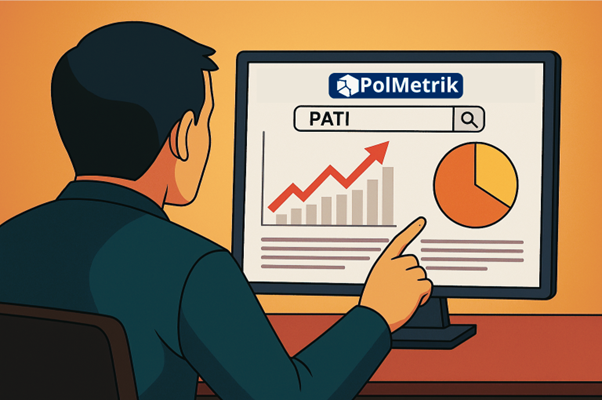The Steep Road of Purbaya in Blocking Illegal Used-Clothing Imports
Finance Minister Purbaya Yudhi Sadewa underscored the government’s uncompromising stance against illegal used-clothing imports, which he stated have harmed the…

Early August 2025 turned into a heated month in Pati Regency—not due to weather, but because political tensions erupted in just days. The name of Regent Sudewo, previously appearing only occasionally in national news, suddenly dominated media headlines, social media timelines, and coffee shop chatter. It all began with one policy: a 250% increase in Rural and Urban Land and Building Tax (PBB-P2).
Data from a media and social media monitoring Polmetrik showed that social media discussions about Sudewo in Pati surged nearly twelvefold between August 4–13, 2025. Whereas previously most discussions focused on development reports and work visits, now 80% of conversations turned into criticism and demands.
On August 5, Sudewo became the center of public attention after the forced dismantling of a logistics post in Pati’s town square went viral. The clash between protesters and Regional Secretary Riyoso added fuel, as did the media coverage highlighting Sudewo’s two explosive statements: a 250% property tax hike and a dare for 50,000 people to protest.

Monitoring showed a significant spike in online activity following the incident, nearly doubling. Criticism and mocking comments poured into Sudewo’s Instagram account, with some even calling for his impeachment.

The issue escalated further in the mass media. Reports of the 50,000-protester challenge and the tax hike spread widely, increasing coverage by 85% in just two days—most of it negative.

Social media conversations also exploded, reaching 10,317 mentions, indicating the high level of public attention.

By August 7, public pressure intensified as media reviews and online conversations surged. Public perception of Sudewo dropped sharply. He eventually revoked the tax hike, citing advice from the Central Java Governor and the Minister of Home Affairs, while apologizing for the turmoil and clarifying his “50,000 protesters” remark.

This appeared as a crisis management move to calm tensions.
Sudewo’s apology and policy reversal improved public perception scores. However, social media and media narratives still revolved around “250%” and “50,000,” with negative and sensitive neutral tones dominating. The crisis proved larger than anticipated.

This became the peak of demonstrations. Although the tax policy had been canceled, tens of thousands (some sources said up to 100,000) still took to the streets. Protesters not only demanded the repeal of the tax but also Sudewo’s impeachment—echoing earlier sentiments.
Other demands included:
The crisis recorded 110,000 engagements across platforms, while news agencies released 3,676 articles about Sudewo and Pati in a single day.

Public perception scores plummeted to 0.01, dropping more than 400% since August 11. Sentiment was dominated by negative and sensitive neutral tones, emphasizing tax rejection and impeachment. On the ground, riots broke out: bottles thrown, fences pushed, police cars burned. Security forces responded with water cannons and tear gas. The local parliament (DPRD) formed a special committee (Pansus) to investigate.
The data revealed three critical indicators:

Sudewo’s case showed how defensive responses worsened the crisis. Revoking the tax and apologizing on August 7–8 slightly lowered tensions, but public discourse had already crystallized into demands for impeachment. By then, corrective steps no longer reversed the tide of negative sentiment above 60%.
The crisis destroyed Sudewo’s political image. His public perception index fell 2,216% in just eight days, plunging from stability to near zero. For a regional leader, such a drop reflects a collapse of legitimacy. With negative sentiment consistently above 60%, clarifications or apologies were no longer enough.
Formally, the DPRD formed a Pansus inquiry into Sudewo’s policies. Regardless of its outcome, the data showed that Sudewo had already lost the public trust sustaining his leadership.
Sudewo’s story in Pati was not only about a 250% property tax hike that was eventually revoked. It was a lesson in how communication failures and policy mismanagement can escalate into a full-blown legitimacy crisis in just days. In the social media era, the line between a “technical issue” and “mass movement” is razor-thin—just one unjust policy, compounded by provocative remarks, can ignite a political storm.
For Sudewo, it was a reminder that being a regional head is not only about administration but also about maintaining public trust. Once trust collapses, even corrective measures lose their meaning.
Writer: Fajar Yudha Susilo, Ilustrator: Aan K. Riyadi
Finance Minister Purbaya Yudhi Sadewa underscored the government’s uncompromising stance against illegal used-clothing imports, which he stated have harmed the…
Over the past month, Indonesia’s political elites, economists, and the general public were stirred by a statement from Finance Minister…
Gus Elham Yahya Luqman, a young preacher from Kediri, East Java, went viral on social media in early November 2025…
The world was thrown into chaos overnight when multiple major internet services went down — including Binokular, whose web-based platforms…
Who would have thought a simple joke could explode into a full-blown social-media drama?Everything began with a viral post comparing…
The 2025 commemoration of National Heroes’ Day turned out to be more controversial than usual. Out of roughly 40 proposed…
Driving his Mercedes-Benz E-Class E300 Coupe, West Java Governor Dedi Mulyadi visited the Danone Aqua plant in Darmaga Village, Cisalak…
October 20, 2025 marks one full year since President Prabowo Subianto and Vice President Gibran Rakabuming Raka began their administration…
What if something as ordinary as the seafood on our dining tables carried an invisible danger? While public attention was…
That afternoon, a call came to the phone of Purbaya Yudhi Sadewa, then head of the Indonesia Deposit Insurance Corporation…